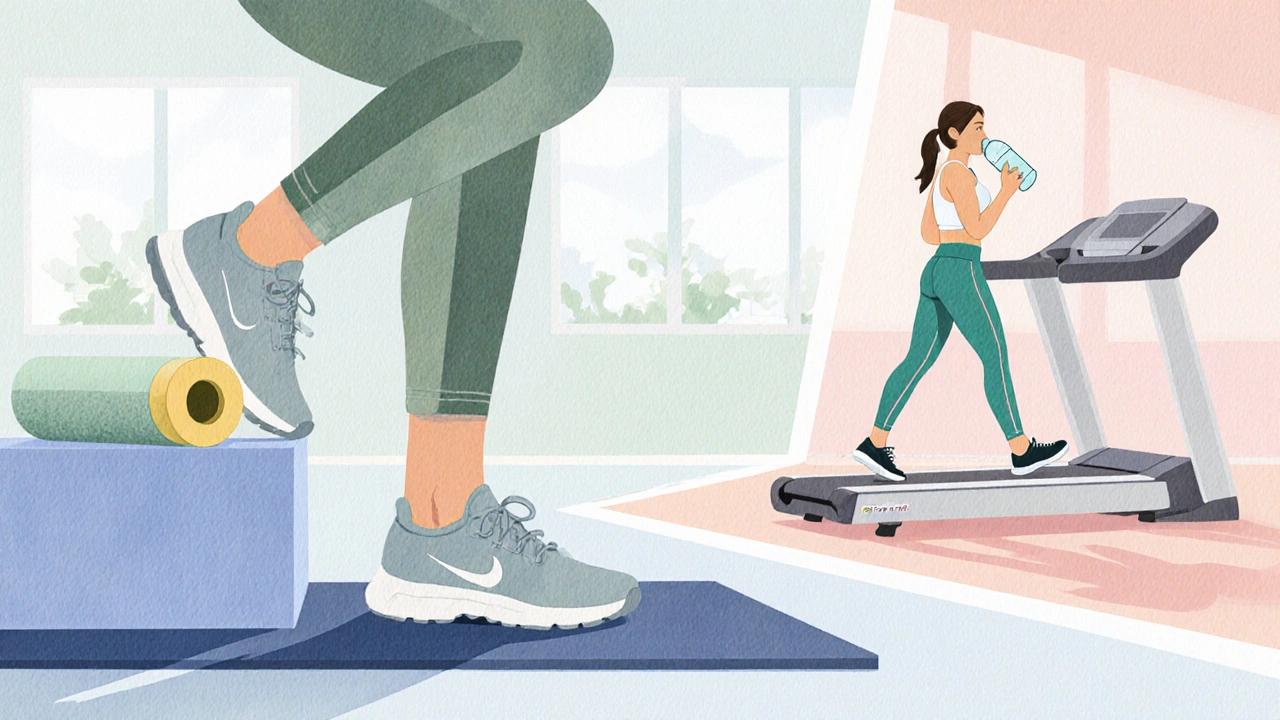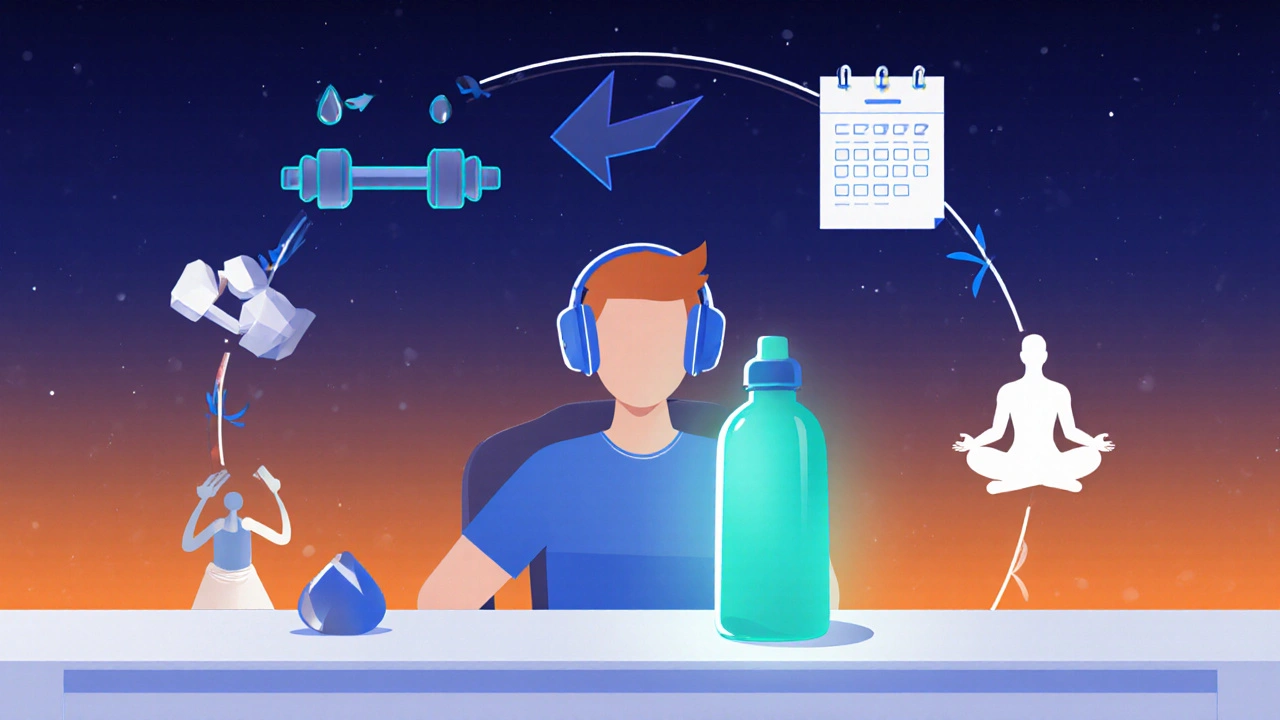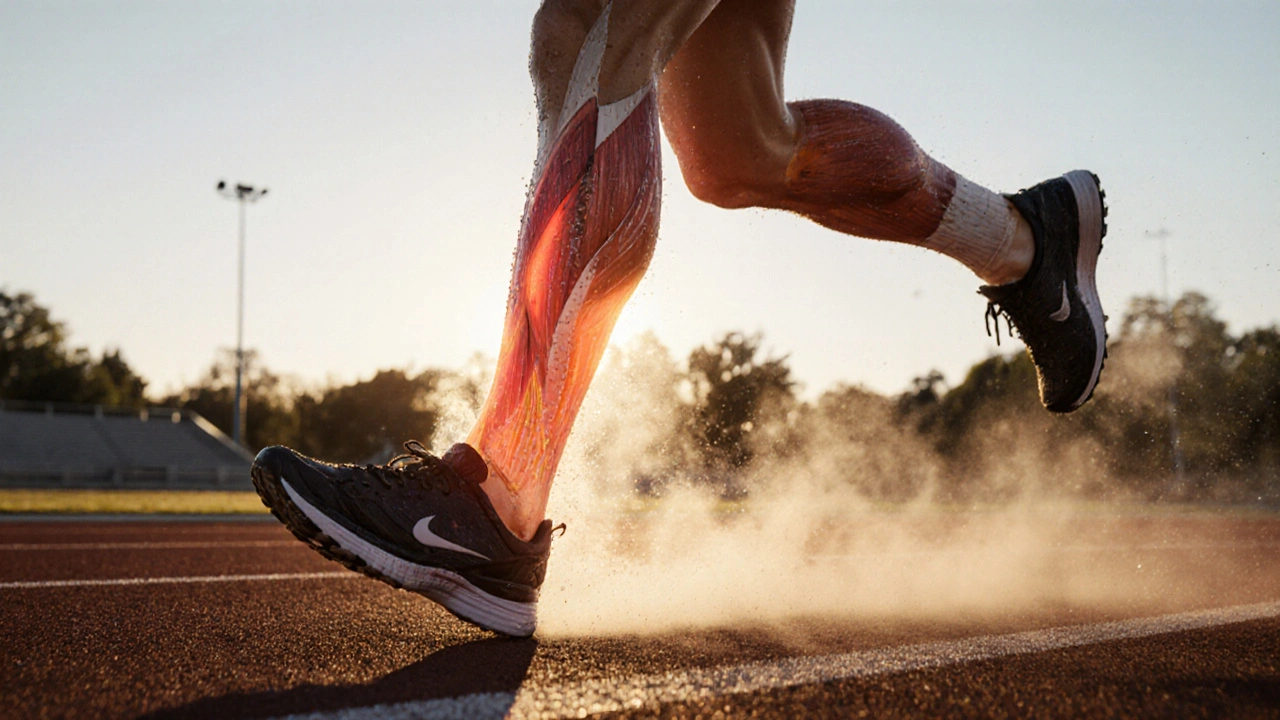Muscle Burn Cause Identifier
Quick Takeaways
- Burning in muscles often signals lactic acid buildup, electrolyte loss, or nerve irritation.
- Hydration, balanced electrolytes, and gentle movement usually calm the flare.
- If the burn lasts beyond 48hours, worsens, or comes with numbness, seek medical advice.
- Regular stretching, progressive training, and proper nutrition prevent most episodes.
- Track patterns - timing, activity, and diet - to pinpoint your personal trigger.
Ever felt a hot, tingling fire rip through a leg or arm after a workout? That muscle burning sensation can be unsettling, but it’s rarely a mystery. Below we break down the most common culprits, what your body is trying to tell you, and practical steps to put out the flame fast.
Muscle burning sensation is a sharp, heat‑like feeling that often appears during or shortly after physical activity. It differs from a dull ache by its intensity and the sensation of heat radiating from the muscle fibers. Understanding why it happens starts with a quick tour of the muscles themselves.
What’s Happening Inside Your Muscles?
When you contract a muscle, tiny fibers called muscle fibers generate force by sliding actin and myosin filaments past each other. This process needs energy, which comes from ATP. If the demand outpaces supply, the body relies on anaerobic pathways, producing lactic acid a by‑product of glucose breakdown without oxygen. Accumulated lactic acid can lower the pH in the tissue, creating that sting‑like burn.
But lactic acid isn’t the only player. Electrolytes-especially sodium, potassium, calcium, and magnesium-act like tiny messengers that keep muscle cells firing correctly. A shortfall throws the electrical balance off, and nerves start misfiring, which you feel as a burning prick.
Top 5 Everyday Causes
| Cause | Typical Trigger | Duration | First‑line Action |
|---|---|---|---|
| Lactic acid buildup | High‑intensity bursts (sprints, HIIT) | 15‑30min post‑exercise | Gentle active recovery, hydration |
| Electrolyte imbalance | Heavy sweating, low‑salt diet | Hours to a day | Electrolyte‑rich drink, salty snack |
| Peripheral neuropathy | Diabetes, vitamin B12 deficiency | Persistent, may worsen | Medical evaluation, supplement if needed |
| Delayed‑onset muscle soreness (DOMS) | Unaccustomed eccentric work | 24‑72h | Light stretching, foam rolling |
| Medication side‑effects (e.g., statins) | Chronic drug use | Variable | Consult prescriber, consider alternatives |

Self‑Care Strategies that Actually Work
- Cool‑down & active recovery: Instead of stopping abruptly, walk or cycle at a low intensity for 5‑10minutes. The gentle blood flow helps clear lactic acid faster.
- Hydrate with electrolytes: Water alone isn’t enough after a sweat‑heavy session. A sports drink or homemade solution (½tsp salt + ¼tsp baking soda + 1L water) restores balance.
- Stretch and roll: Target the burning muscle with a static stretch held for 30seconds, followed by a foam‑roller massage. This improves tissue elasticity and reduces nerve irritation.
- Heat‑then‑cold contrast: Apply a warm compress for 3minutes, then switch to an ice pack for 1minute. The alternating temperatures reset nerve signaling.
- Nutrition boost: Include magnesium‑rich foods (leafy greens, nuts) and vitamin‑B complex sources (whole grains, eggs) in your post‑workout meal to aid muscle recovery.
When to Call a Professional
Most burns fade with the steps above, but some red flags deserve a doctor’s eyes:
- Pain that doesn’t improve after 48hours.
- Accompanying numbness, tingling, or weakness.
- Swelling, redness, or fever - signs of infection or inflammation.
- History of diabetes, kidney disease, or chronic medication use.
In those cases, a clinician may order blood work to check electrolyte levels sodium, potassium, calcium, magnesium concentrations in serum or assess nerve function through electromyography.
Preventing Future Burns
Prevention is a habit, not a one‑time fix. Here’s a simple weekly checklist:
- Warm‑up for at least 5minutes with dynamic stretches.
- Gradually increase intensity - follow a 10% rule (no more than 10% workload increase per week).
- Stay hydrated throughout the day; aim for½liter per hour of activity.
- Include electrolyte‑rich snacks (bananas, pretzels) during long sessions.
- Schedule a rest day or low‑impact activity (yoga, swimming) after heavy lifts.
Real‑World Example
Mark, a 34‑year‑old graphic designer, started a HIIT program after months of desk work. Within three days he felt a burning sensation in his calves after each session. He tried a quick shower and rest, but the pain stuck around. By following the self‑care steps-adding a sports drink, stretching calves after workouts, and cutting his HIIT sessions to 20minutes-Mark’s burns vanished in a week. He now tracks his water intake with a smart bottle, preventing repeat episodes.

Frequently Asked Questions
Can dehydration cause a burning feeling in muscles?
Yes. When you lose water, you also lose electrolytes that keep muscle cells firing properly. The imbalance can trigger nerve irritation that feels like a burn. Rehydrating with a balanced electrolyte solution typically resolves the sensation.
Is lactic acid the only cause of a burning muscle during exercise?
No. While lactic acid contributes to the early burn, factors such as low magnesium, nerve compression, or medication side‑effects can produce similar sensations. Identifying the exact cause often requires looking at the whole picture - diet, activity, and health history.
How long does DOMS usually last?
Delayed‑onset muscle soreness peaks around 24‑48hours after the workout and typically fades within 72hours. Gentle movement and stretching can shorten the recovery window.
Should I stop exercising if I feel a burning sensation?
Not necessarily. Pause, reduce intensity, and apply the active‑recovery steps. If the burn continues despite rest, or if it’s accompanied by sharp pain or weakness, stop and seek medical advice.
Can certain medications make muscles feel like they’re on fire?
Yes. Statins, some antihypertensives, and chemotherapy agents can cause myalgia or a burning sensation. Talk to your prescriber about dosage adjustments or alternative drugs if the symptom is persistent.


Burning muscles are just your body screaming for a break.
Yep,‑‑stop, hydrate, stretch, and let it cool down.
It is a curious phenomenon that the corporeal vessel, when subjected to exertion beyond its accustomed threshold, begins to emit a sensation akin to burning; this is not a mere anecdote but a physiological cascade rooted in biochemistry.
The primary actor in this cascade is the accumulation of lactate ions, which arise when glycolytic pathways dominate in the absence of sufficient oxygen.
As the intracellular pH declines, nociceptors are sensitized, transmitting the characteristic sting to the central nervous system.
Parallel to lactate, electrolyte derangements-particularly sodium, potassium, and magnesium-disrupt the electrochemical gradients essential for orderly muscle contraction.
When sweating ensues profusely, these electrolytes are excreted, and the resultant imbalance precipitates a misfiring of neural signals, often interpreted as burning.
Moreover, the myofibrillar microtrauma incurred during eccentric contractions initiates an inflammatory response, releasing prostaglandins that further sensitizes pain pathways.
The temporal profile of these mechanisms varies: lactate‑induced burn typically manifests within minutes, electrolyte‑related discomfort may emerge after hours, while delayed‑onset muscle soreness peaks 24 to 48 hours post‑exercise.
Intervention, therefore, must be tailored to the presumed etiology.
Immediate active recovery, such as low‑intensity cycling, aids in the clearance of lactate via enhanced perfusion.
Rehydration with isotonic solutions restores osmolar balance and mitigates neuronal irritability.
Adjunctive modalities-contrast therapy, foam rolling, and static stretching-address micro‑injury and facilitate metabolic waste removal.
Nutritional considerations, including magnesium‑rich foods and adequate protein intake, further support muscular repair.
Persistently burning sensations accompanied by paresthesia, weakness, or swelling warrant medical evaluation to exclude neuropathic or vascular pathology.
In such instances, diagnostic work‑up may encompass serum electrolyte panels, nerve conduction studies, and imaging as indicated.
Ultimately, the principle remains consistent: respect the body's signals, provide appropriate recovery, and seek professional counsel when red‑flag symptoms arise.
Listen up-if you’ve got that burn, grab a sports drink loaded with electrolytes, do a 5‑minute light jog, then hit the foam roller hard; no excuses, just do it.
Ah, the age‑old myth that lactic acid is the villain-how delightfully simplistic. One would think contemporary readers crave such reductive narratives.
Totally agree; there’s more to the story than a single chemical.
🔥🔥🔥 I swear my legs turned into lava pits after that HIIT session-felt like I was on fire!! 😂
I understand the intensity can feel overwhelming, but maintaining proper hydration and balanced electrolytes will significantly reduce that scorching sensation.
People should stop pushing their bodies to the limit, it's just reckles and can lead to serious health issues.
Sure, because ignoring your body's warning signs is always a brilliant idea.
Great job on completing that workout!!! Remember to cool down properly, stretch those muscles, and sip on an electrolyte drink!!! 😊
Exactly, a balanced routine with proper recovery is key to preventing that burning feeling.
Hey everyone, just wanted to share that listening to your body and adjusting intensity can make a huge difference.
Indeed the practice of calibrating one’s exertion levels in accordance with personal physiological feedback represents a cornerstone of sustainable fitness development and, when coupled with systematic hydration strategies, nutrient timing, and intentional rest periods, serves to mitigate the onset of uncomfortable burning sensations that can otherwise discourage continued participation in physical activity; thus, embracing a holistic approach not only preserves musculoskeletal health but also enhances overall well‑being.
If the burn lasts more than two days or you feel numbness, see a doctor right away.
Frankly, the post overlooks the critical role of ion channelopathies in chronic burning sensations, an omission that betrays a superficial grasp of neuromuscular physiology.